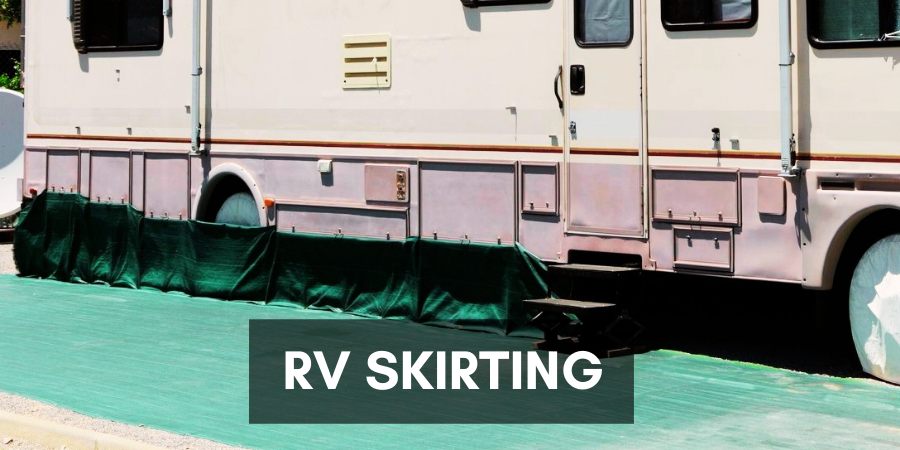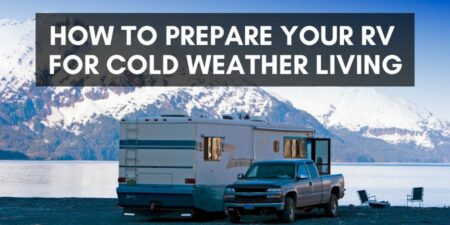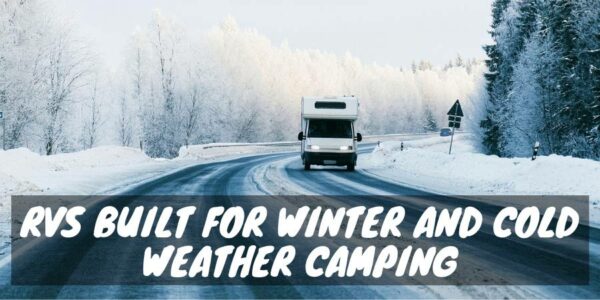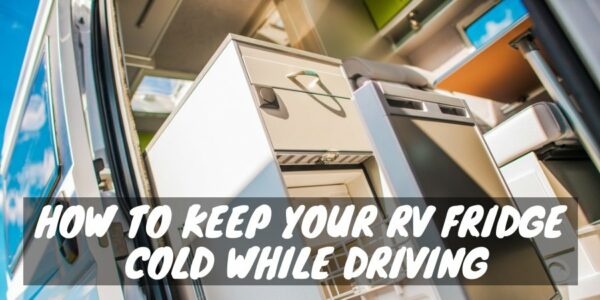Skirting is a lifesaver for cold-weather RVers as it provides many benefits to your camper and its occupants.
Adding skirting to your RV is an excellent idea in winter, but many people think it’s too expensive or difficult to install, so they often skip it and pay the price.
To help answer all your questions about putting RV skirting on a fifth wheel, motorhome, or travel trailer, I put together this guide where you’ll find information on:
- What is RV skirting
- RV skirting benefits
- RV skirting options with pros and cons
- Average cost of professional or DIY RV skirting
What is RV Skirting?
RV skirting is a temporary wall that closes off the space between the bottom of your RV and the ground. The skirting attaches in such a way to allow you to take it off when you move your RV to a new location.
The purpose is to stop air and debris from going under your RV to protect your camper’s underbelly components. Most RVers choose to skirt their camper only during cold months or when they leave their RV parked in one location for many seasons.
Different materials are used for RV skirting, such as fabric, vinyl, styrofoam, metal, and wood, but some work much better than others to keep out the cold.
Where you park your RV for winter camping will determine which type of skirting you use, as some campgrounds forbid skirting entirely or only allow a specific material or look.
Many recreational vehicle owners, especially those with fifth wheels, use a snap-on skirt around the camper nose in all seasons so they have a protected space for camping gear and to hide the hitch. Unfortunately, this partial skirting is more cosmetic and does very little to benefit the RV as a whole during cold temperatures.
DIY RV Skirting (Video)
RV Skirting Benefits
The purpose of RV skirting in winter is for temperature control and protection of your RV’s underbelly and components.
Adding skirting to an RV brings these benefits:
- Traps air and holds heat under the RV
- Lowers propane and electricity expenses
- Protects plumbing lines and holding tanks against freezing and cracking
- Keeps snow, ice, and leaves from accumulating under the camper
- Can stop animals from going under camper
- Makes the RV flooring warmer and more comfortable in winter
Blocking the wind and cold air from blowing under your RV instantly increases the temperature of the camper underbelly, which houses many critical components like water lines and waste tanks.
In winter, frigid air can freeze water in the tanks and lines, causing it to expand and crack and leaving you with annoying and expensive repairs. The prevention of this type of damage is the main reason to skirt an RV in winter.
Skirting traps the air between the ground and the RV. The area will warm up as you heat your camper interior, and the air comes in contact with the warm floor and undercarriage.
As the underside of the RV remains warmer, so does the flooring inside the camper, making it much more enjoyable for people and pets to stand on.
The improvement of the warmer floor decreases the need for continual heating inside the RV, helping reduce the amount of electricity or propane necessary to maintain a comfortable temperature.
Skirting also keeps snow or debris from blowing underneath the RV that can damage components or make it difficult for your camper to move when you change campsites. The skirting can also help deter animals from hiding out or taking up residence under the recreational vehicle.
Do You Need RV Skirting if the Camper Has an Enclosed Underbelly?
Skirting is a great addition, no matter if your RV has an enclosed underbelly or not.
Even RVs with insulated and heated underbellies will find skirting helps maintain a more comfortable winter camping environment. The lower the winter temperatures drop, the more an RV skirt will protect at-risk camper components from the elements.
Many modern RV designs are now “four-season” models. Still, even winter-ready motorhomes or travel trailers will have difficulty keeping occupants warm and water lines from cracking during extremely cold weather events.
RV skirting is the solution that protects your investment and improves winter camping life.
RV Skirting Options
Next up are the top materials for RV skirting, with a list of pros and cons to help you compare options.
Vinyl Fabric RV Skirting
- Extremely strong and flexible and is easily cleaned with a damp cloth.
- Ideal for upholstery, arts, crafts and especially for use on boats or aquatic vehicles. Approximately 1.5 pounds per yard
- Great for Boat Seats, Upholstery, Restaurant Booths, Bar Stools, Table Cloths, Purses, Crafts, Workout Equipment, ATV Seats,…
- Completely waterproof, highly resistant to cuts, scratches, dirt, and the sun’s UV.
- 1 Yard Shipped Folded: 2+ Yards Shipped on a Tube. (If purchased through Amazon Prime, multiple yards will be shipped as 1 yard…
Vinyl fabric skirting is by far the most popular choice for RVers, as the material is easily customizable to fit any type of recreational vehicle.
This RV skirting method is available through professional companies, or you can DIY the project using materials you purchase and install yourself.
The material for the skirting is dense and often has a waterproof membrane or coating on one side to further block wind and rain from getting under your RV.
Most fabric skirting for RV will have a channel or small loops at the bottom to insert a heavy rod or ground stakes to help keep the material in position.
You attach the skirting around the perimeter of the RV via:
- Snaps
- Twist locks
- Velcro
- Slip-in channel tracks
All of the above attachments make it easier and faster to adhere the skirting to your RV once you set up at your campsite and to remove it when you leave.
I’ve found that you can typically find a guest at seasonal or long-term RV parks who makes custom-fit skirting as a side gig.
You can also measure your RV dimensions and order a semi-made kit from a company that will supply the correct sizes of material and all the instructions and accessories necessary to complete the project. You can sew and attach the skirting kit yourself or give it to a local who has the equipment and skills to finish the job.
Kits are a nice hybrid option that creates a professional-looking RV skirt using quality fabric that is more affordable than hiring an expert skirting company and less stressful than trying to purchase all the materials yourself.
RV Vinyl Fabric Skirting Pros:
- Easy to install and remove
- Can be folded for storage during travel days
- Improves RV appearance
- Can customize to match RV color scheme
- Traps a good amount of heat
Cons of RV Vinyl Fabric Skirting:
- The fabric eventually deteriorates and fades and will need replacement
- Must secure the loose bottom to the ground for best results
- Often has gaps that allow cold wind to penetrate under the RV
- Attachment points on the RV perimeter may look unattractive when the skirting is off
If you’re interested in professional RV skirting, check out Custom Skirting, LLC, or Custom Canvas Unlimited, which both get great reviews from customers.
RV Skirting Pros is another top company that also gives you the option of ordering the materials for a DIY RV skirt if you want to save money.
EZ Snap is a fantastic source for a kit that includes the vinyl and hardware for your model RV, so you don’t have to run around searching for various attachment components.
RVers looking for the most affordable DIY RV fabric skirting purchase used billboard material, as one side is usually a solid color. You can buy the billboard vinyl in bulk from eBay or by contacting a local billboard company.
Inflatable RV Skirting
Inflatable RV skirting is new to the industry but has many benefits that other skirting options don’t deliver.
The company that introduces this style is AirSkirts, which makes long tubes out of durable vinyl material that you lay on the ground just underneath the edge of your RV and inflate.
The tubing is flexible and tough enough to conform to any irregular edges or shapes under your RV for a tight seal without puncturing.
Different size tubes fit between tires and the front, side, and back of any type of Class A, Class B, or Class C motorhome, travel trailer, teardrop camper, or fifth-wheel.
AirSkirts comes with an electric air pump for fast inflation.
Inflatable RV Skirting Pros:
Cons of Inflatable RV Skirting:
- Doesn’t need attachment hardware on RV
- Fast installation and removal
- Compacts for space-saving storage
- Creates a good seal against cold and snow
- Punctures can happen if not careful
- Expensive
- Appearance may not be acceptable for some RV parks
- Can leave some open-air gaps
Inflatable RV skirting is a unique choice that may work wonderfully for winter camping enthusiasts who like to move to campsites often.
The ability to adjust the amount of tube inflation is very helpful when snowfall changes the height between the bottom of your camper and the ground or when the terrain isn’t level.
AirSkirts Camper Skirting Installation (Video)
Foam Board Insulation RV Skirting
Foam board insulation is another popular option for skirting an RV in cold weather, especially in northern regions.
You can purchase the boards in 4′ x 8′ sections and custom-cut them to fit perfectly around your stationary RV. The panels typically come in white or pink or have a solid white or reflective silver finish on one side.
To create a tight seal over gaps, you use a compatible tape over the joints, which also aids in keeping the foam board in place.
Foam Board RV Skirting Pros:
- Affordable
- Lightweight
- Easy to cut and customize the fit
- Creates a higher insulation value versus fabric skirting
- It can look nice if done well
Want to Connect With a Community of Over 1,078 RV Enthusiasts?
Cons of Foam Board RV Skirting:
- Will need 5-8 sheets for most RVs
- Easy to damage when installing or removing
- Hard to reuse, making it a less eco-friendly choice
- It will require lots of storage space if you move the RV
The slight flexibility of the foam board allows you to install the pieces using only pressure between the RV and the ground. For brutal winter winds or snowstorms, you can also add screws around the perimeter to hold it tight, but this will leave permanent damage on your camper.
How to Skirt a Trailer with Foam Board (Video)
Plywood, Metal, or Solid Vinyl RV Skirting
Any type of rigid RV skirting is best for recreational vehicles that stay put for long periods.
You can use solid vinyl panels, more commonly used on mobile homes or park model RVs, that slip into each other and sit in a track that attaches to your camper and the ground.
The connection makes a solid seal against weather and animals, and you can add foam board insulation backing inside to increase undercarriage warmth.
Additionally, you can choose to cut loose sections of vinyl, plywood, or even sheet metal and attach them with screws around your RV perimeter. This option will leave holes around your RV, which can impact resale value, but it should hold the material securely.
- Mobile Home Skirting Vinyl VENTED Underpinning 16″ Wide x 35″ Tall Panel.
- Color: White.
- Panel Thickness: .037″
- 10 Panels Per Pack.
- Can Be Trimmed Shorter On The Job Site.
Many RV parks will forbid plywood RV skirting because it looks terrible, even if you paint it. Plywood is also a poor choice for winter RV skirting as it will absorb moisture, begin to rot out, and draw insects like ants and termites to your rig.
Rigid RV Skirting Pros:
- Will hold up better against constant winter weather
- Can use materials or paint to match your RV exterior
- Can add foam board backing for a higher R-value rating
- More affordable than some other skirting options
Cons of Rigid RV Skirting:
- Requires permanent holes in RV for attachment
- Plywood and metal are heavy and awkward to cut, install, remove, and store
- May not be acceptable for some RV parks
- Plywood will rot and attract pests
Of all the options for rigid RV skirting, I suggest you stick to the solid vinyl panels, as they look and stop wind the best and stack up into 2-foot-wide sections for travel days, making them easier to store.
Solid Vinyl RV Skirting Installation and How to Do IT Yourself (Video)
Cost of Different RV Skirting Options
Here is the average cost of the different RV skirting options. Pricing will vary due to how much material is necessary, as a motorhome or travel trailer will require less square footage of skirting than a fifth wheel.
Vinyl Fabric RV Skirting Cost:
| Professional | $1,200 up to $2,800 |
| Custom-ordered Kit | $700 up to $1,500 |
| DIY | $400 up to $1,200 |
Inflatable RV Skirting Cost:
- Airskirts start at $1,699 and go up to $2,999 for a high-clearance kit
Foam Board RV Skirting Cost:
- Panel type/thickness variations will run from $120 up to $250
Rigid RV Skirting Cost:
| Plywood | $175 up to $300 |
| Sheet Metal | $180 up to $400 |
| Vinyl | $200 up to $500 |
Emergency RV Skirting Options
You can quickly install a barrier from other materials in a pinch if you want to protect your RV pipes from freezing during an unusual cold snap.
Many RVers carry a roll of Visqueen or thick plastic and duct tape it around their camper edges and add rocks or wood to hold the bottom in place. You could also use tarps if you have enough.
Another option, if you already have sufficient snowfall, is to bank up the snow to fill the gap around your RV. Packed snow does an excellent job of trapping air and heat and only requires some physical work to install, with no hit to your wallet.
Final Thoughts
Do you really need RV skirting? For fair-weather camping, probably not.
But for cold-weather camping, it’s going to make your RV much more comfortable, reduce heating costs, and help maintain the integrity of your holding tanks and water lines so you can avoid damage and leaks.
In other seasons of the year, skirting can improve the look of your camper and hide and protect camping gear you tuck underneath your RV when not in use. If you often travel to new campgrounds, select a skirting that is easy to remove and store.
I hope this guide to RV skirting solutions helps you see the value of adding a barrier around your recreational vehicle during the winter months so you can save money and camp in comfort!
How to Skirt Your RV for Winter with Rigid Foam (Video)
"Man cannot discover new oceans unless he has the courage to lose sight of the shore."
-- Andre Gide













What clips do you use to hold and nail to ground??